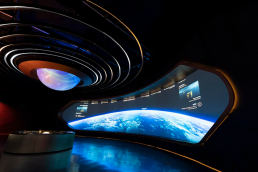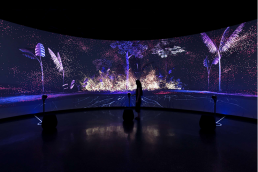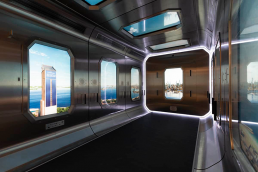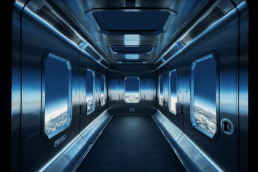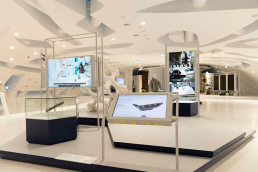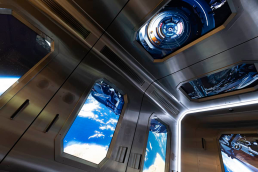This website uses cookies so that we can provide you with the best user experience possible. Cookie information is stored in your browser and performs functions such as recognising you when you return to our website and helping our team to understand which sections of the website you find most interesting and useful.
Museum of The Future
ProjectMuseum of The FutureLocationDubai, UAEArchitectAtelier Bruckner, GermanyLighting DesignerAtelier Bruckner, Germany (Visual Designer)InstallerAVI-SPLSubmitted byAVI-SPL
The Museum of the Future is a global architectural structure that uses technology to inspire visitors to pioneer new worlds and ways of living. AVI-SPL’s immersive exhibits integrate space, content, and technology to create interactive storytelling experiences that spark wonder in audiences of all ages and backgrounds. Visitors engage with an array of next-generation technologies, including massive projection walls, augmented reality, multi-sensory exhibits, and human-machine interaction.
Other features include An AI-powered digital guide that welcomes guests via an expansive 3m by 3m LED screen. An AVI-SPL’s integration of Quuppa’s RTLS technology extends the smart museum concept with customized wayfinding.
The Sand Bath installation which offers a unique sensory experience shaped by vibration, light, and water. An interactive projection on the floor simulates sand and wind conforming to visitors’ movement within the space. As well as, a stunning installation of a 21m by 4m screen with 14 rear projectors that simulates a near-Earth orbit station.
Throughout their journey, visitors’ sensory experiences are reinforced by the use of water scents, vibrational haptics, and touch interfaces. These simulations, and other exhibits, are powered by 48 displays, 44 projectors, 300 speakers, and 76 media servers across five stories in the 320,000 sq ft building.
Sunder Raman, Technology Director at Museum of the Future said: “AVI-SPL has been the best partner to help the MOTF’s creative vision come to life. The AVI SPL team had to be able to work closely with MOTF’s creative partners, often being required to interpret ideas and execute them with technical finesse.
“AVI-SPL was required to consider network engineering, projection calibration, hardware fabrication, mobile app integration, and holistic systems management and monitoring. This is a tall order for most AV firms. The added stress of a compressed timeline and the logistical complexities of COVID required a team of AV specialists that were internationally dispersed, but simultaneously who could deliver in person in Dubai. AVI-SPL was able to deliver to these expectations.”
AVI-SPL is proud to be a part of the team that brought the vision of the museum to life. And we’re thrilled that we were able to deliver innovative solutions – and customer delight.”
Throughout the entire exhibition, Q-Sys is the muscle behind all the signal processing and playback. Paired with Fohhn loudspeakers, the team built a true multi-channel experience throughout every space. In total, there are over 400 channels of audio being used as each speaker is driven and audio-tracked individually. The overall solution creates an amazing soundscape throughout each space.
For some of the most intense spaces, AVI-SPL had the privilege to work with Micah Silver, co-founder of Polytope Agency in Los Angeles, who created an amazing soundscape all custom mixed on-site to achieve a truly mesmerising experience.
From wrap-around immersive projection, LED floors, giant LCDs and fine pitch dvLED walls; visual AV technology was vital to placing museum visitors in the future and taking them on a journey of inspiration and discovery.
Barco projection dominated almost every space with a mix of single-chip and three-chip DLP projectors, all lamp free for a sustainable operation. In some of the more sensitive spaces, Barco’s engineering team worked with AVI-SPL to modify the UDM line-up to accommodate remote cooling units to keep noise and waste heat to a bare minimum within the exhibition space.
To power this amazing visual experience, the team turned to 7th Sense and its Delta media playback platform. All spaces are driven at the projector or display native resolution, this meant some serious horsepower was needed behind the scenes to generate the content uninterrupted 365 days a year. 7th Sense worked with the team to ensure we kept the variety of playback servers to a minimum, while still achieving perfect playback.
With projection, playback is only one piece. AVL-SPL also had to ensure the image reproduction was perfect every day. The team partnered with Scalable Display Technologies to enable automatic warping and blending of all projection areas each morning prior to the first guest’s arrival at the museum. This has made operations and maintenance of the projection systems much smoother and guarantees we never have a projector out of alignment.
AVI-SPL was awarded the honour of bringing an ambitious creative vision to life in the iconic Museum of The Future in Dubai. Our highly skilled teams adeptly addressed multiple challenges throughout the project and integrated a total of 48 displays, 44 projectors, 300 speakers, and 76 media servers across five stories in the 320,000-square-foot building, all within a tight timeframe.
One of the most challenging aspects of this project was installing a Barco RigiFlex, the world’s largest Powerwall screen, which measures an impressive 10m in length. When RigiFlex is installed and tensioned, it is exceptionally durable but before that it is very susceptible to damage. With only one chance to get it right, our specialists spent months researching and testing to ensure a flawless installation.
The technical installation presented a formidable obstacle due to the distinctive geometric structure of the building. Our team collaborated closely with the architect and designers to optimise the space, fulfil the complex requirements, and execute the installation precisely according to the plan.
Managing multiple stakeholders, an extensive range of technology, and the diverse requirements of various teams was another challenge. Early on, it streamlined and simplified the hardware deployment process to meet the museum’s requirements.
The collaborative efforts with all stakeholders ensured the seamless rendering of content and perfect frame rates so that all content looked spectacular within the space. Additionally, each provider had unique demands, including working with their custom software, but with our effective communication and superior project management skills, we successfully accomplished our end goal.
The project faced additional challenges from the wide range of demands on hardware, the volume of content providers and the large amount of uncompressed, native content, – all of which required coordination across different languages and time zones. Specialist engineers efficiently managed this process by coordinating with the companies, allowing for seamless integration and content performance testing to ensure successful delivery.
